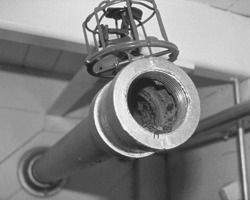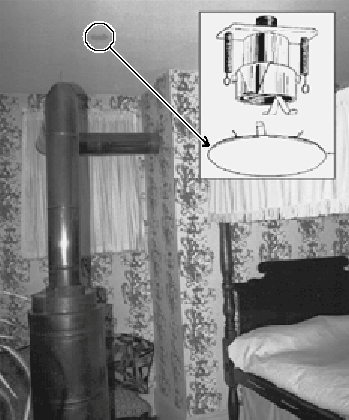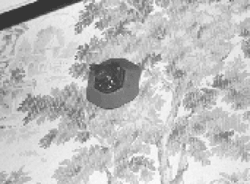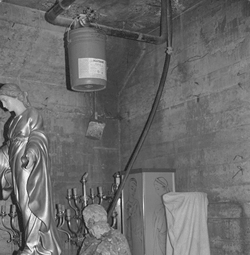Automatic Sprinkler Systems for Museums – Canadian Conservation Institute (CCI) Notes 2/8
(PDF Version, 1.33 MB)
CCI Note 2/8 is part of CCI Notes Series 2 (Preventive Conservation)
Introduction
The myths that caused museumFootnote † staff to fear water damage from sprinkler systems have gradually been debunked. Contrary to notions that sprinkler heads activate all at once, they do so only as required, one by one, and usually one to three sprinklers are sufficient to control a fire. They are not activated by smoke, only by heat (normally between 57 and 77°C). Sprinklers cause much less water damage than do fire department hoses. They deliver water at the rate of approximately 113.75 L (25 gallons) per minute at the seat of the fire, whereas fire department hoses deliver about 10 times that amount, with extreme pressure directed in a general area of the fire, at times damaging more collections than necessary. Sprinkler systems are currently the most effective means available to protect collections from fire and more museums are installing them than ever before. Selecting the best sprinkler system can be a daunting task for any museum manager. This Note provides important information to help museum staff make the right choices from the beginning.
System Reliability
The reliability of sprinkler systems is quite impressive. According to the National Fire Protection Association (NFPA), from to , sprinkler systems provided satisfactory performance in almost 96% of fire incidentsEndnote 1 in over 80,000 fires involving sprinklers. Furthermore, Australian Fire Protection Association statistics reveal a 99.5% reliability rate based on all fires involving sprinkler systems in Australia and in New Zealand from to .Endnote 2 Most failures could have been prevented through good design and maintenance practices. Lack of water as a result of closed valves, partial sprinkler protection (e.g. basement level only), inadequate water supply due to poor design calculations, freezing, and extensive dry-pipe systems are some causes of system failures. Reliability can theoretically exceed 99%, which is probably as high or higher than the reliability of any fire protection system.Endnote 3
Systems
Some museums have installed elaborate sprinkler systems designed to reduce the risk of water damage. On/off sprinklers, pre-action systems, and cycling systems are some examples. They are very expensive to purchase and to install, are often a maintenance nuisance, and are less reliable than conventional wet-pipe systems. A case in point is the U.S. Library of Congress experience. Approximately 1800 on/off sprinklers had to be replaced by conventional sprinklers in the book stacks of the Adams and Jefferson buildings because of a rare manufacturing defect. Expectations of reduced water damage may have been exaggerated, because on/off sprinklers opened by fire must operate for a minimum length of time before shutting themselves off. Whether they flow for 15 or 25 minutes will not substantially alter the amount of water damage to collections located in the fire area. This opinion is supported by the National Research Council of Canada in testing on/off sprinklers for the National Library of Canada. Pre-action and cycling systems are not recommended for museum collections because they totally depend on a fire detection system to activate. The danger of accidental water discharge is often exaggerated. Sprinklers are very rugged, and are made to withstand far greater water pressures than required. Special systems are not required to protect collections against water damage.
The most reliable sprinkler system on the market today is the traditional wet-pipe system. It is fast, effective, simple to maintain, and relatively inexpensive. Some museums are still reluctant to install wet-pipe systems because the piping contains water. They fear water could discharge accidentally if a sprinkler becomes defective or is struck. This fear is not well founded and is certainly not based on museum experience or sprinkler malfunction records. It has been estimated, based on sprinkler leakage loss reports, that the chance a sprinkler will open accidentally because it is defective is less than 1 in 16 million installed sprinklers per year.Endnote 4 Sprinkler systems are designed to withstand a pressure of at least 3448 kPa (500 psi) without injury or leakage.Endnote 4 Proper installation methods can make accidental activation just about impossible. Water-filled piping also has advantages: water curtails the pipe rust and scale normally found in dry-pipe systems (Figure 1), and wet-pipe systems do not depend on air exhaust valves, dry-pipe valves, or fire detection systems to deliver water.

Dry-pipe systems are not recommended for protecting collections because they are slower and have a higher failure rate than wet-pipe systems. The slower response time can result in greater fire spread, requiring the eventual opening of more sprinkler heads and more water being discharged. Another argument against dry-pipe systems is pipe rust and scale build-up, because scale and sediment can cause serious damage to collections. This build-up is caused mainly by oxygen and moisture in empty pipes, and is increased by moisture and condensation from room humidity, the air supply drawn by the dry-pipe air compressor, wetting of pipe walls when the dry-pipe valve is tripped accidentally or during a fire, and when full-flow trip tests are carried out. Piping can be filled with nitrogen to reduce rust and scale, but this adds to the initial cost and becomes another maintenance issue. A dry-pipe system should be installed only where interior heat is not adequate to prevent water freezing in the system.
Micromist sprinkler systems are presently being developed. They work on very high pressure and discharge a fog-like mist throughout the room. Tests at the University of Maryland indicate fires can be suppressed very effectively with just a few gallons of water.Endnote 5 Micromist systems fight fires by cooling, displacing oxygen, and reducing heat transfers between flames and nearby objects. Systems and installation costs are expected to be similar to standard wet-pipe sprinkler systems. Approved systems and standards should be available for museum installations in . One should keep in mind that a debugging period of a few years is well worth considering before proceeding with any new system.
Criteria to Consider
The following criteria should be considered when installing an automatic sprinkler system in a museum. (This section may provide guidance to architects and engineers hired to design systems for museums.)
Designer: Although some sprinkler firms have knowledgeable sprinkler designers on staff, it is preferable to use the services of a competent professional engineer registered in the province of installation. This offers a non-biased representation during the design, inspection, and testing stages.
Design: The system should be designed, installed, and tested in conformance with NFPA 13, Standard for the Installation of Sprinkler Systems. Hydraulic calculations are recommended in most cases. Some installations should be based on performance tests. Protection for mobile shelving is an example.
Systems: Sprinklers should be installed in every room throughout the building; partial fire protection is not adequate. A wet-pipe system should be installed in all heated areas and a dry-pipe system (instead of a glycol system) in areas subject to freezing.
Zone valves (shut-off valves): Zone valves should be located so they are visible and easily accessible. Installing them at floor level, i.e. 1.2–1.5 m (approximately 4–5 feet), rather than ceiling level (as is usually done) allows the water to be stopped promptly after suppression of the fire. In one known case, excessive water damage occurred in a national museum because staff and firefighters could not quickly locate sprinkler valves.
Sprinkler valve room: Sprinkler valves and other peripheral sprinkler equipment, such as an air compressor in a dry-pipe system, should be located in a separate room dedicated to this purpose. This room should be identified with a sign on the door reading "SPRINKLER VALVE ROOM." The door should never be locked, and the room should not be used for storage. Valves should be permanently labelled for quick and easy identification. A sprinkler zone plan should be prepared and made available to firefighters upon their arrival.
Water density: It should be based on the type and amount of artifacts expected on a room-by-room basis, or projected collections in temporary exhibit rooms. For example, combustibility ratings, rates of heat release, storage height, and the presence of flammable and combustible liquids should all be considered.
Mobile storage: Mobile storage is often used in collection and archive storage rooms, and in research and library rooms. Density calculations should take into consideration dense fuel loads created by higher quantities of artifacts, minimum clearance space between shelving, and the type of mobile storage system installed. Automatic fire mode features that leave a minimum space of 10 cm (4 in.) between each module should be considered. This space can help sprinklers suppress fires by providing an opening for water to reach fires inside the shelving.
Piping: Schedule 40 or equivalent steel piping is acceptable in most wet-pipe systems. Galvanized piping is recommended for dry-pipe systems. Thermoplastic and copper piping is recommended in areas where installation may be difficult, such as in historic house museums.
Sprinkler protection: To reduce the risk of damage to sprinklers, upright (Figure 1), recessed (Figure 2), or sidewall (Figure 3) sprinklers should be installed rather than pendent sprinklers. If pendent sprinklers are located in areas where they could be subject to damage, wire cages (Figure 1) should be installed over them.


Fire department connections: Ordinary covers should be provided on exterior fire department connections. Brass covers are attractive items that bring a fair return at the scrap yard. These are often found to be missing during site visits leaving connections unprotected for long periods, or until needed. It is not unusual to find rubbish, such as pop cans, rocks, and paper, blocking connections when covers are missing.
Conclusion.
Automatic sprinkler systems are the best means known today to protect collections from fire and from water damage caused by fire department hose line operations. Sprinkler systems are rugged and are not nearly as prone to water leaks as plumbing and drain pipes (Figure 4). Wet-pipe systems are recommended in most applications. Sprinklers can be installed so as to prevent accidental activation caused by mechanical injury. Installations should be designed to meet special needs to protect collections.

Recommended Reading
-
Artim, Nick, Director of Fire Safety Network, Middlebury, Vermont. "An Introduction to Automatic Fire Sprinklers Part 1." WAAC Newsletter, vol. 16, nº 3 ().
-
Artim, Nick. "An Introduction to Automatic Fire Sprinklers." WAAC Newsletter, vol. 17, nº 2 ().
-
Artim, Nick. "An Update on Micromist Fire Extinguisher Systems." WAAC Newsletter, vol. 17, nº 3 ().
-
Baril, Paul. "Fire Prevention Programs for Museums." CCI Technical Bulletin 18. Ottawa: Canadian Conservation Institute, .
-
Canadian Conservation Institute. "Fire Protection Issues for Historic Buildings." CCI Notes 2/6. Ottawa: Canadian Conservation Institute, .
-
Canadian Conservation Institute. "Museum Fires and Losses." CCI Notes 2/7. Ottawa: Canadian Conservation Institute, .
-
Richardson, J. K. "The Reliability of Automatic Sprinkler Systems." Canadian Building Digest, nº 238 (). Ottawa: National Research Council of Canada.
-
Wilson, J. Andrew, Chief, Fire Protection Division, Smithsonian Institution. "Fire Fighters." Museum News (/).
Written by Paul Baril
Copies are also available in French.
Texte également publié en version française.
© Minister of Public Works and Government Services,
Cat. Nº NM95-57/2-8-1998E
ISSN 0714-6221